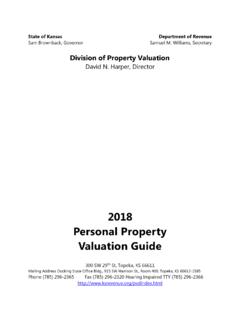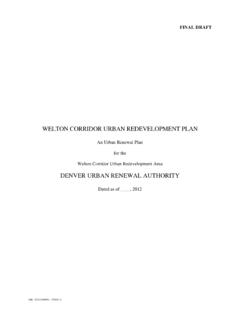Transcription of Access to rural land and land administration after violent ...
1 ISSN 1020-31178 Access to rural landand land administrationafter violent conflictsLAND TENURE STUDIES8 FOOD AND AGRICULTURE ORGANIZATION OF THE UNITED NATIONSRome, 2005 land TENURE STUDIESFAOA ccess to rural landand land administrationafter violent conflictsFAOLand Tenure StudiesFAO s land Tenure Studies are concise presentations on theoften complicated and controversial subject of land tenure,especially as it relates to food security, poverty alleviationand rural development. These studies do not seek to beexhaustive but instead reflect what FAO and its many inter-national collaborators have discovered are good practices for a particular aspect of land tenure and its studies cover various aspects of improving Access toland and other natural resources and increasing tenure secu-rity.
2 They address the role of land tenure in rural develop-ment, gender and Access to land , improved Access to landthrough leasing arrangements, rural property taxation sys-tems, land consolidation, and land Access and land adminis-tration after violent information on the land Tenure Studies, and on FAO swork in land tenure, is available at: prepared by David Palmer, Nigel Thomson,Paul De Wit, Jonathan Lindsay, Mika-Petteri T rh nen,Pamela Pozarny and Paul Panel: Bengt Andersson, Clarissa Augustinus,Francisco Barquero, Florence Egal, Vladimir Evtimov,Annie Kairaba-Kyambadde and Jon INTRODUCTION12.
3 POST-CONFLICT SETTINGS5 violent conflicts and their causes5 The start and end of the post-conflict period7 Characteristics of the post-conflict environment10 The displacement and return of refugees and Internally Displaced Persons163. land TENURE IN POST-CONFLICT SETTINGS19 land tenure and its administration19 Access to land in post-conflict settings24 land administration in post-conflict settings27 Customary lands30 The importance of considering land tenure in post-conflict settings324. ASSISTANCE IN ASSESSMENT MISSIONS355. ASSISTANCE WITH EMERGENCY ACTIVITIES39 Recognition of land tenure problems40 The land tenure system42 Adjudication of land rights43 Need for land45 Availability of land46 Operational framework47 Policy framework49 Legal framework49 Inter-agency coordination51 Communication52 Identification of priorities52 Design and implementation of short-term actions536.
4 ASSISTANCE WITH THE DEVELOPMENT OF POLICIES57 Restitution60 Resettlement63 Establishment of an operational system65Co-ordination and communication677. ASSISTANCE WITH THE IMPLEMENTATION OF POLICIES698. FINAL COMMENTS73 ForewordThe present volume is part of a series of land Tenure Studiesproduced by FAO s land Tenure Service of the RuralDevelopment Division. land tenure arrangements are a keyto food security and sustainable rural development. Equitableand secure Access to land , especially for the rural poor, is acrucial factor for reducing poverty and hunger, for increasingagricultural productivity, and for improving rural land tenure institutions are needed to administerwho has rights to what natural resources for which purposes,for how long, and under what conflicts typically cause significant changes toland tenure and its administration .
5 A widespread conflictlasting for a number of years may result in successive wavesof displacement of people. People may lose their land becausethey have been forcibly evicted, or they may abandon theirland because of fear of violence. Those displaced are forcedto seek land to settle, either within the country as InternallyDisplaced Persons, or externally as refugees. People livingin safer areas may have lost Access to their land with thearrival of those who are displaced. At the end of a conflict, many people return home only tofind that others occupy their property. In some cases suchoccupants may not have a valid claim.
6 In many other casesthe waves of displacement result in several people havinglegitimate claims to the same parcel of land . Many peoplewill not be able to return to their original home areas and willhave to settle secure Access to land is particularly complex insituations following violent conflicts . A wide range of peopleand organizations require Access to land for a variety ofpurposes. In some cases temporary Access is required; in othercases more permanent arrangements are needed. Resolvingclaims to land and ensuring Access to it are often hamperedby a weak capacity of central and local levels of processes for managing land restitution and resettlementprogrammes must often be designed and infrastructure must be replaced, land records mustbe recovered or recreated, and technical and managerialexpertise must be volume is intended to support land tenure and landadministration specialists who participate in the recreationof land tenure and its administration in countries followingviolent conflicts .
7 The book, like others in the series, does notseek to be exhaustive but rather reflects what FAO and itsmany collaborators have discovered are good practices .FAO s rural Development Division looks forward tocontinuing collaboration with its larger Koohafkan DirectorRural Development Division1. IntroductionSecure Access to land is a crucial factor in the eradication of hunger andpoverty. Providing secure Access to land is frequently not easy, and it isparticularly complex in situations following violent conflicts . Getting theanswer right can go directly to the matter of achieving sustainable emergency humanitarian needs after a conflict requires findingplaces for people to live in the short-term under conditions that providesafety for them and which do not threaten the rights to land of longer-term social and economic stability requires finding morepermanent solutions to where people can live and work.
8 Yet too often,initiatives for recovery and reconstruction are planned without consideringthe need to resolve land tenure problems. violent conflicts arise for many reasons. Some violent conflicts have theirroots in disputes over Access to land . In many other cases, land tenure isnot a fundamental cause of violence although land disputes may add to thetensions. Regardless of the origin of a conflict, widespread violence overa period of years results in the massive displacement of much of thepopulation. People become landless. Vulnerable groups almost invariablyinclude women and children, and may also include ethnic or politicalminorities.
9 At the end of a conflict, Access to land is required by people whowere displaced. Many people try to get back their own land . They may faceseveral competing, legitimate claims to the same land as a result ofsuccessive waves of displacement. Many others may not be able to recovertheir lands and have to settle elsewhere. The effects of violent conflicts are usually widespread in a country but theycan be particularly severe in rural areas. conflicts often occur in poorcountries where much of the population is rural : poor countries have thecharacteristics of a relatively low level of urbanization and a relatively highpercentage of the labour force working in agriculture.
10 Widespread conflictsin poor countries can thus result in the displacement of vast numbers of1 Access to rural land and land administration after violent in rural areas. Following the conflict, a lack of roads and other ruralinfrastructure and the difficulty of working in rural areas may limit theattention paid to rural problems. Recovery from a violent conflict is hugely difficult. It must address the massdispersal of people from their lands, widespread death and injury within thepopulation, destruction of critical infrastructure, collapse of the legal system,loss of records and expertise, widespread mistrust, and continued fear andthreat of violence.















